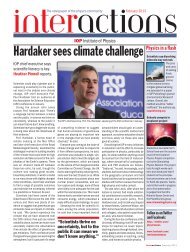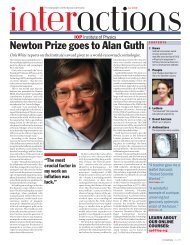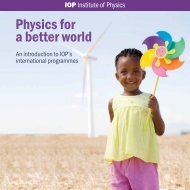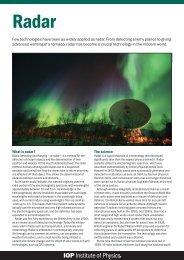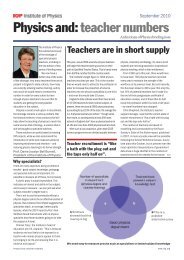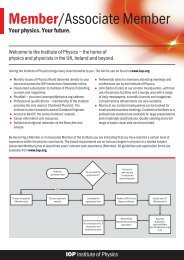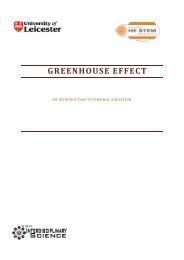Girls in the Physics Classroom: A Teachers' Guide - Institute of Physics
Girls in the Physics Classroom: A Teachers' Guide - Institute of Physics
Girls in the Physics Classroom: A Teachers' Guide - Institute of Physics
Create successful ePaper yourself
Turn your PDF publications into a flip-book with our unique Google optimized e-Paper software.
2: Lessons from research<br />
Table 2.3: Teachers’ preconceptions about students’ achievements<br />
Topic <strong>Girls</strong> Boys<br />
How difficult do<br />
students f<strong>in</strong>d, e.g.<br />
very not at all very not at all<br />
electric circuits and symbols 1 2 3 4 5 1 2 3 4 5<br />
8. The f<strong>in</strong>d<strong>in</strong>gs reported here<br />
come from <strong>the</strong> section 3 <strong>of</strong><br />
Murphy and Whitelegg’s report.<br />
2.1d Review<strong>in</strong>g action taken<br />
A questionnaire with a five po<strong>in</strong>t scale, (e.g. appendix 4.2)<br />
can be used to monitor <strong>the</strong> impact <strong>of</strong> <strong>in</strong>terven<strong>in</strong>g to change<br />
girls’ experience <strong>of</strong> physics. If you have attempted change,<br />
you could re-adm<strong>in</strong>ister <strong>the</strong> questionnaire to f<strong>in</strong>d out if students’<br />
views have shifted.<br />
2.2 The curriculum perspective 8<br />
Did you know?<br />
Curriculum relevance<br />
● Gender-determ<strong>in</strong>ed notions about <strong>the</strong> personal<br />
relevance <strong>of</strong> physics lessons also <strong>in</strong>fluence feel<strong>in</strong>gs <strong>of</strong><br />
competence. Perceptions about relevance cause<br />
students to choose to, or to feel able to, engage with<br />
learn<strong>in</strong>g and <strong>the</strong>y <strong>the</strong>refore <strong>in</strong>fluence what <strong>the</strong>y are<br />
able to learn. For example, some boys will avoid<br />
activities about health and domestic situations while<br />
o<strong>the</strong>rs will approach <strong>the</strong>m tentatively. Some girls will<br />
avoid activities featur<strong>in</strong>g mach<strong>in</strong>ery if <strong>the</strong> emphasis is<br />
on mechanics and <strong>the</strong> purpose is not socially relevant<br />
(e.g. health and safety).<br />
● What boys, more than girls, pay attention to and feel<br />
competent <strong>in</strong> is generally valued and judged to be<br />
relevant <strong>in</strong> physics.<br />
● Differences <strong>in</strong> perceptions <strong>of</strong> relevance also affect <strong>the</strong><br />
problems that students identify. <strong>Girls</strong> are more likely<br />
than boys to give value to <strong>the</strong> social context <strong>in</strong> which<br />
activities are set; boys are more likely than girls not to<br />
focus on <strong>the</strong> context.<br />
● A UK study <strong>of</strong> A-level physics teachers reported that<br />
girls found electrical circuits, electromagnetism and<br />
mechanics more difficult than boys did. Ma<strong>the</strong>matics<br />
teachers agreed about mechanics be<strong>in</strong>g more difficult<br />
for girls. Boys and girls <strong>in</strong> <strong>the</strong> study considered that<br />
<strong>the</strong>y were equally successful across all topics.<br />
Curriculum <strong>in</strong>terventions<br />
● Curriculum changes that <strong>in</strong>crease girls’ engagement<br />
and achievement <strong>in</strong> physics have no detrimental effect<br />
on boys’ overall achievement and <strong>in</strong> some cases <strong>the</strong>y<br />
have improved all students’ performance.<br />
● Some students, particularly some boys, reject <strong>the</strong>se<br />
curriculum changes because <strong>the</strong>y have learned not to<br />
pay attention to social contextual issues and feel<br />
disadvantaged when required to do so.<br />
Could this be happen<strong>in</strong>g <strong>in</strong> your school?<br />
Some questions to consider:<br />
● Do you th<strong>in</strong>k that <strong>the</strong>re are physics topics or aspects <strong>of</strong><br />
physics that are more difficult for girls than boys?<br />
● Do students differ <strong>in</strong> what <strong>the</strong>y believe <strong>the</strong>y are good at<br />
<strong>in</strong> physics?<br />
● Is this affect<strong>in</strong>g how <strong>the</strong>y engage with topics <strong>in</strong><br />
physics?<br />
● Are <strong>the</strong>re gender differences <strong>in</strong> test results for <strong>the</strong>se<br />
topics; for which girls and which boys?<br />
2.2a F<strong>in</strong>d<strong>in</strong>g out what is happen<strong>in</strong>g <strong>in</strong> your school<br />
Student questionnaires<br />
If you used question 4 <strong>in</strong> <strong>the</strong> first questionnaire <strong>in</strong> appendix<br />
4.2, you will have <strong>in</strong>formation at topic level about students’<br />
views <strong>of</strong> how well <strong>the</strong>y understand topics.<br />
Teacher questionnaire<br />
You might want to exam<strong>in</strong>e o<strong>the</strong>r teachers’ as well as your<br />
own preconceptions about <strong>the</strong> achievement <strong>of</strong> students <strong>in</strong><br />
physics. To do this, you could list <strong>the</strong> topics <strong>in</strong> your student<br />
questionnaire on a s<strong>in</strong>gle side <strong>of</strong> A4 paper and <strong>the</strong>n ask<br />
colleagues to rate how well <strong>the</strong>y consider that girls overall,<br />
and boys overall, do <strong>in</strong> relation to <strong>the</strong>m. Use two columns<br />
side by side (table 2.3). If you are work<strong>in</strong>g <strong>in</strong> a s<strong>in</strong>gle-sex<br />
school, you can still use such a questionnaire but use only<br />
one column. You could use <strong>the</strong> follow<strong>in</strong>g open-ended question<br />
after <strong>the</strong> list to f<strong>in</strong>d out colleagues’ reasons for <strong>the</strong>ir<br />
views. What do you base your views on?<br />
● research<br />
● analysis <strong>of</strong> performance<br />
● experience<br />
● observation<br />
You could follow up this questionnaire with <strong>in</strong>terviews to<br />
probe colleagues’ views and <strong>the</strong> basis for <strong>the</strong>m.<br />
Observations<br />
You can use an observation schedule to consider:<br />
● how girls and boys approach tasks and if <strong>the</strong>re is a<br />
gender effect;<br />
● how well students understand <strong>the</strong> physics tasks<br />
through <strong>the</strong>ir engagement with <strong>the</strong> tasks.<br />
What you plan to observe will vary, depend<strong>in</strong>g on <strong>the</strong> type<br />
<strong>of</strong> school that you are <strong>in</strong> and what questions you want to<br />
explore. It is useful to set yourself a specific period <strong>of</strong> <strong>the</strong><br />
lesson for observ<strong>in</strong>g. You might want to observe overall<br />
behaviours:<br />
● If you allow students to choose <strong>the</strong>ir groups, what<br />
group<strong>in</strong>gs do <strong>the</strong>y prefer?<br />
● If you select groups, which arrangements are <strong>the</strong> most<br />
successful?<br />
● If it is practical work, which students collect<br />
equipment? How was this decided?<br />
● If <strong>the</strong>re is a plann<strong>in</strong>g element to <strong>the</strong> activity, are <strong>the</strong><br />
14 I NSTITUTE OF P HYSICS R EPORT G IRLS IN THE P HYSICS C LASSROOM: A TEACHERS’ GUIDE FOR A CTION D ECEMBER 2006




